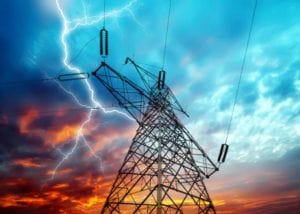Wade Leipold is the executive vice president of Faith Technologies Incorporated (FTI). FTI is a certified EcoXpert™ and is proud to partner with Schneider Electric to provide EcoStruxure™ IoT open architecture building management and security systems to our clients. A dynamic organization comprised of construction, engineering, manufacturing, and renewable energy experts, we create success for our partners and team members through innovation and expertise, rethinking how energy is designed, applied, and consumed – providing solutions that go beyond the ideas of today.
All industrial facilities depend on electricity, but not all electricity is created equal. Poor power quality can cause a host of problems. We call it the “silent killer” of sensitive machinery and industrial efficiency.

In our day-to-day interactions with clients at Faith Technologies we see poor power quality as a growing issue with many causes. As companies expand, new machines are often added to individual facilities without considering the impact on power quality. For example, installing drives without line reactors can overload circuits and cause voltage sags. These disruptions lead to downtime and increase the risk of premature failure. Unplanned maintenance and replacement costs further impact the bottom line. Efficiency and sustainability suffer.
On a broader scale, adding more complex equipment to the grid can cause electrical disruptions. This can make electrical distribution systems more prone to quality issues, especially in parts of the United States where the grid is already overly taxed.
Why power quality goes unaddressed
Regrettably, enhancing power quality often falls low on the priority list, even though neglecting it can result in equipment damage, production stoppages, and decreased efficiency. To combat these issues, organizations need more electrical specialists with expertise in this area. However, such professionals may already be occupied with daily operational duties or lack the resources to take a preventative approach.
Since power quality issues build up slowly and don’t cause immediate breakdowns, they often don’t get the attention they need. Even apparent signs, such as flickering lights or nuisance trips, may go unaddressed until something more serious happens. If machines run and lights turn on, the power is considered “good enough.”
However, like a chronic health condition, poor power quality does not improve through neglect. As facilities mature, age takes its toll on power distribution equipment. When new outlets, fixtures, and equipment are added, the electrical system becomes more complex and challenging to diagnose, especially without the proper metering installed.
Decarbonization implications of power quality
Improving power quality can lead to direct and indirect decarbonization benefits. For example, a 30-horsepower drive that fails due to poor power quality requires a replacement. Producing this new drive creates carbon emissions. By maintaining high-quality power, you can reduce equipment failures and the need for new, emissions-intensive manufacturing.
Enhanced power quality also supports efficient production. It eliminates the need for extended work shifts to meet targets, which reduces overall energy use and emissions. Even if these emissions are not produced on-site, reducing them impacts your carbon footprint. Specifically, these reductions contribute to lowering Scope Three emissions. Scope Three emissions are indirect emissions that occur in the value chain of your operation, such as those generated by vendors or the production of purchased goods.
How do you know when to start investigating power quality?
Some signs of power quality problems are clear and immediate, such as unexpected shutdowns, premature equipment failures, or even flickering lights. Yet other problems, like high harmonic distortion in voltage, often go unnoticed. We sometimes find distortion of 7 percent or greater—more than enough to cause operational disruption—where the client is unaware of the problem. Metering is necessary to uncover and fix these problems.
The type of industry you work in can also indicate the likelihood and severity of power issues arising. While most industries have equipment that can cause distortion, some are more prone than others.
In manufacturing, variable frequency drives and large industrial motors may be the culprits.
Healthcare settings often see medical imaging equipment, uninterruptible power supplies (UPS), laser surgery equipment, dialysis machines, and battery chargers cause harmonics issues. For data centers, UPS, variable frequency drives in cooling systems, power distribution units, and servers with switched-mode power supplies are sources of reoccurring power quality problems.
Assessing electrical performance becomes crucial when costly and vulnerable equipment, such as medical imaging devices or precision manufacturing machinery, is in play. Industries like petrochemical and semiconductor manufacturing, where downtime costs are exceptionally high, also have much to gain from targeted evaluations of their electrical systems. The same applies to facilities that operate mission-critical systems, such as hospitals, data centers, and emergency response centers.
However, all these industries can realize significant benefits from targeted power quality improvement efforts.
A phased approach to improving electrical performance
A cost-effective strategy for improving your power quality and electrical performance begins with deploying temporary meters in suspected problem areas. The data gathered serves two purposes: diagnosing and remedying immediate issues while identifying zones that warrant further investigation.
Once problem areas are pinpointed, transitioning to at least some permanent metering often makes sense. These strategically placed meters will facilitate ongoing monitoring and predictive maintenance. For example, if temporary meters reveal high harmonic distortion in your equipment, permanent ones can continuously track the efficacy of installed harmonic filters.
The value of visibility
Robust metering and data collection infrastructure can forecast the impact of equipment changes, such as upgrading a drive’s horsepower, and implement safeguards against disruptions. This makes your system not just responsive but also resilient and future-ready.
Visibility into the power system enables quick identification of the root cause, often eliminating the need for time-consuming diagnostics. Immediate actions like part replacement or command adjustments can reduce the time and cost involved in solving the problem, and also reduce downtime.
The first step toward improving power quality is a detailed assessment to identify practical, cost-efficient solutions. As a certified EcoXpert, our close partnership with Schneider Electric offers a wide variety of monitoring solutions for your power quality and metering needs. Building on their expertise and technological innovations, we give our customers the best and most sustainable, options possible.
For more information
Learn more about how we can help you optimize your company’s power quality and increase your ROI with our integrated metering solutions. With expertise across all our divisions – Faith Technologies®, EnTech Solutions™ and Excellerate® – we are one connected company, bringing our partners’ visions to life to ensure a sustainable future. For more information, visit faithtechinc.com.
Ready to increase your own sustainability knowledge and know-how? Learn more with Schneider Electric’s Sustainability School.
EcoXperts are the enablers of net-zero buildings
The EcoXpert Partner Program is unique in its industry and made up of a best-in-class, global ecosystem of expertise. Trained and certified by Schneider Electric, EcoXpert partners digitize and electrify our world for a more sustainable future.
The path to net zero is about delivering solutions for sustainable, resilient, efficient, and people-centric buildings. For our EcoXpert partners, this unveils immense growth opportunities through the transition to end-to-end portfolio sales that will resolve our customers’ most critical needs. For our shared customers, this means that together with our EcoXpert partners, we will drive the building industry transformation and help our customers survive and thrive today – and tomorrow.
Visit the EcoXpert webpage to learn more.


